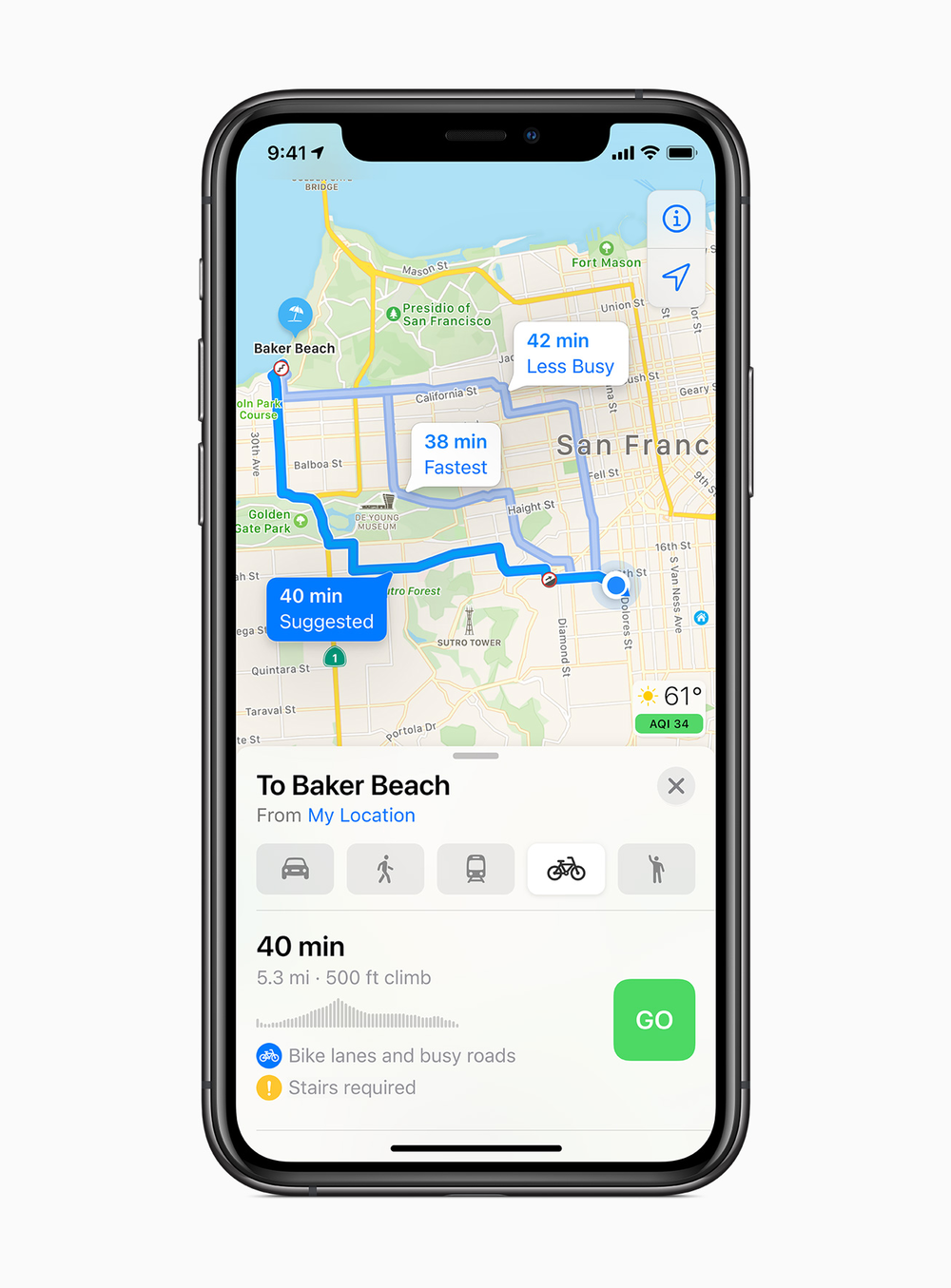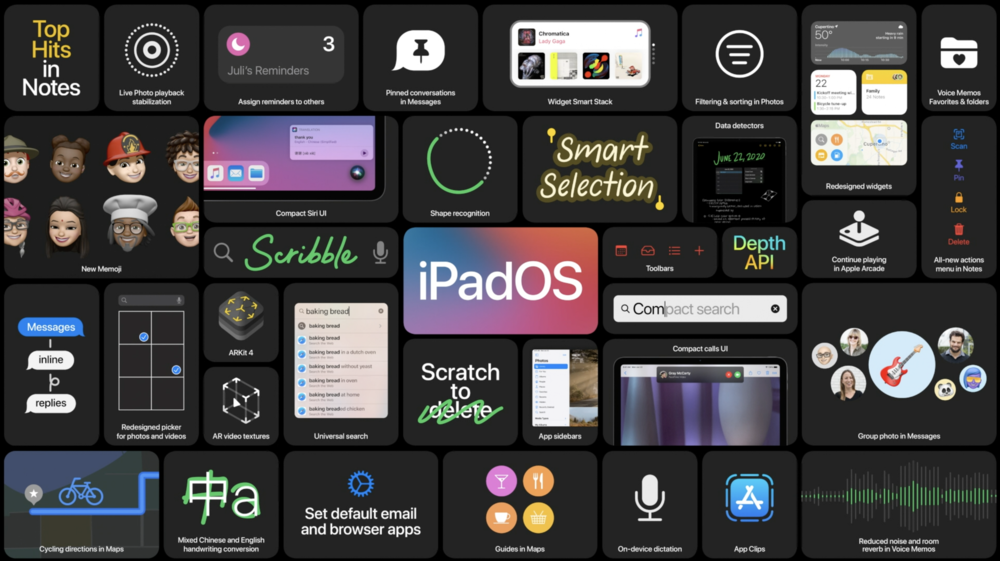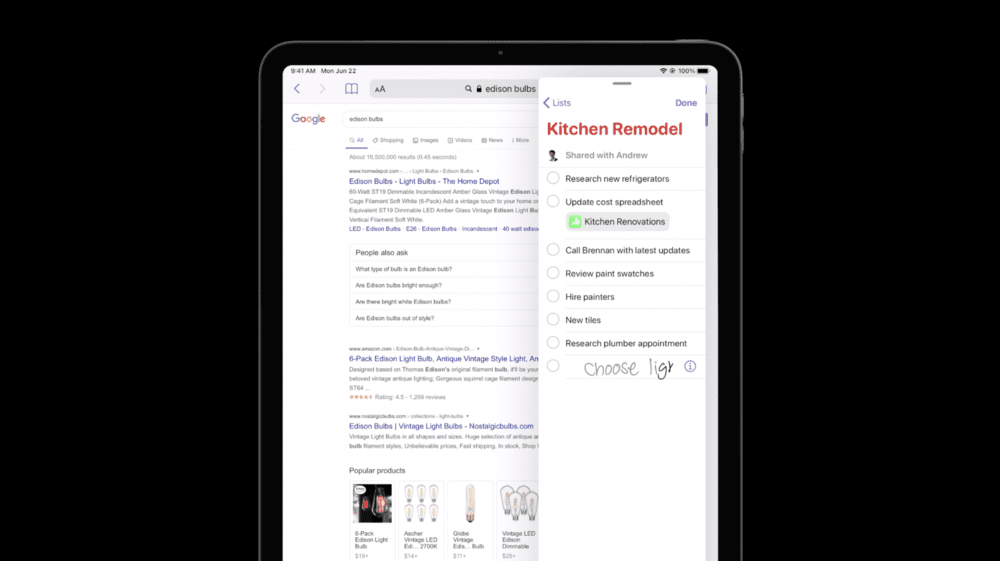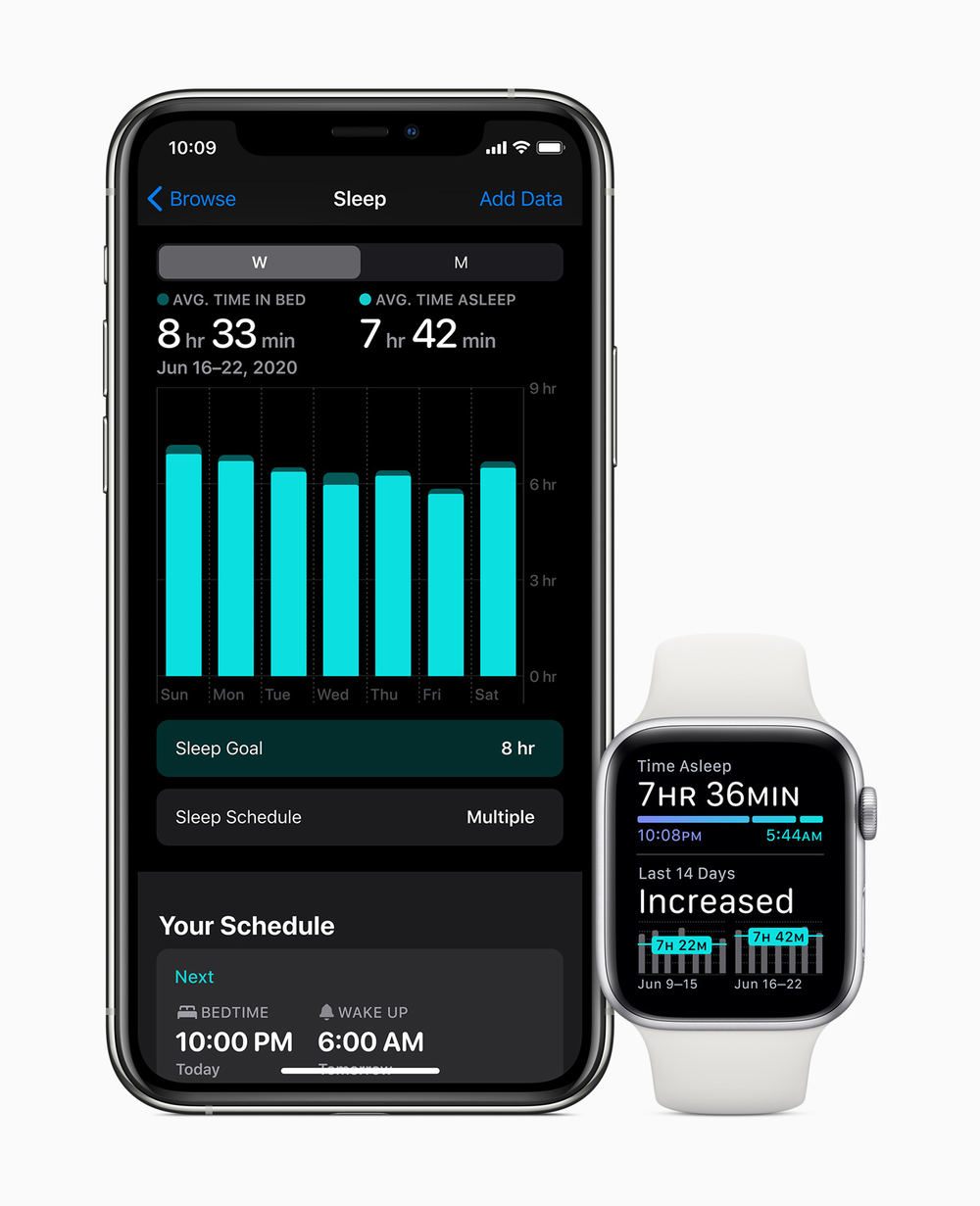Clear out some time on your calendar tomorrow, because if you have a lot of Apple devices, you may be spending a few hours doing upgrades to the latest Apple operating systems. iOS 14, iPadOS 14, tvOS 14 and watchOS 7 will all be available tomorrow. In case you haven’t been paying attention, here are the top features of the upcoming upgrades:

iOS 14
At the virtual Worldwide Developer Conference, Apple previewed iOS 14, which saw a major update to Home Screen pages with redesigned widgets and the App Library, a new way to tap into the App Store with App Clips, updates to Messages, and more.
The new widgets present timely information at a glance and can be pinned in different sizes on any Home Screen page. Users can create a Smart Stack of widgets that uses on-device intelligence to surface the right widget based on time, location, and activity, according to Craig Federighi, Apple’s senior vice president of Software Engineering.
“This helps you get info at a glance,” he adds. “The Home Screen is more beautiful and data rich.”
Home Screen pages can display widgets that are customized for work, travel, sports, entertainment, and other areas of interest. At the end of the Home Screen pages is the App Library, a new space that automatically organizes all of a user’s apps into one view, and intelligently surfaces apps that may be helpful in the moment, says Federighi. Users can choose how many Home Screen pages to display and easily hide pages for quicker access to the App Library.
Incoming FaceTime and phone calls and Siri interactions take on an all-new compact design that enables users to stay in the context of what they’re doing. With Picture-in-Picture support, iPhone users can now watch a video or take a FaceTime call while using another app.
An App Clip is a small part of an app experience designed to be discovered the moment it is needed. App Clips are associated with a particular product or business, and load within seconds to complete a specific task, such as renting a scooter, purchasing a coffee, or filling a parking meter. They can be discovered and accessed by scanning a new Apple-designed App Clip code, or through NFC tags and QR codes, or shared in Messages or from Safari.
With Messages, users can now pin conversations to the top of their messages list, keep up with group threads through mentions and inline replies, and further customize conversations by setting a group photo using an image or emoji, according to Stacey Lysik, senior director, Apple.
“You can pin conversations at the top of your list,” she adds. “There are now over one trillion ways to customize a message’s look with Memoji and we’re adding more Memoji options that are more inclusive and diverse with additional hairstyles, headwear, face coverings, and more.”
iOS 14 also adds in-line replies to group messages. While in a group message, you can type someone’s name to replay to that person. You can also create a unique visual look for a Messages group.
Meg Frost, product design for Apple Maps, says Maps in iOS 14 makes it easier than ever to navigate and explore with new cycling directions, electric vehicle routing, and curated Guides. Cycling directions take into account elevation, how busy a street is, and whether there are stairs along the route. Electric vehicle routing adds charging stops along a planned route based on current vehicle charge and charger types.

Guides provide a curated list of interesting places to visit in a city, created by a selection of trusted resources. Frost says that guides are a great way to discover hot new restaurants, find popular attractions, and explore new recommendations from respected brands, including AllTrails, Complex, The Infatuation, Time Out Group, and The Washington Post, among others.
Frost says the cycling and electric vehicle features are coming to Coming to New York City, Los Angeles, LA, San Franciso Bay Area, Shanghai, and Beijing at first with more cities added over time.
With iOS 14, Federighi says apps will now be required to obtain user permission before tracking. Later this year, App Store product pages will feature summaries of developers’ self-reported privacy practices, displayed in a simple, easy-to-understand format, he adds.
In addition, users can upgrade existing accounts to Sign in with Apple, choose to share their approximate location with app developers rather than their precise location when granting an app location access, and get even more transparency into an app’s use of the microphone and camera.
Federighi says additional iOS 14 features will include:
-
Translate is designed to be the best and easiest app for translating conversations, offering quick and natural translation of voice and text among 11 different languages. On-device mode allows users to experience the features of the app offline for private voice and text translation.
-
Siri expands its knowledge, helps find answers from across the internet, and can now send audio messages. Keyboard dictation runs on device when dictating messages, notes, email, and more.
-
The Home app makes smart home control even easier with new automation suggestions and expanded controls in Control Center for quicker access to accessories and scenes. Adaptive Lighting for compatible HomeKit-enabled lights automatically adjusts the color temperature throughout the day, and with on-device Face Recognition, compatible video doorbells and cameras can identify friends and family.
-
Digital car keys give users a secure way to use iPhone or Apple Watch to unlock and start their car. Digital car keys can be shared using Messages, or disabled through iCloud if a device is lost, and are available starting this year through NFC. Apple also unveiled the next generation of digital car keys based on Ultra Wideband technology for spatial awareness delivered through the U1 chip, which will allow users to unlock future car models without removing their iPhone from their pocket or bag, and will become available next year.
-
Find My will add support for finding third-party products and accessories with the new Find My network accessory program. This will allow customers to use the Find My app to locate other important items in their lives, in addition to their Apple devices. User privacy remains central to the Find My network with end-to-end encryption built in. A draft specification is available for accessory makers and product manufacturers starting today.
-
Safari offers a Privacy Report so users can see which cross-site trackers have been blocked, secure password monitoring to help users detect saved passwords that may have been involved in a data breach, and built-in translation for entire webpages.
-
Health has all-new experiences to manage sleep, better understand audio levels that may affect hearing health, and a new Health Checklist — a centralized place to manage health and safety features — includes Emergency SOS, Medical ID, ECG, Fall Detection, and more.10 Health also adds support for new data types for mobility, Health Records, symptoms, and ECG.
-
The Weather app and widget keep users up-to-date on severe weather events and a new next-hour precipitation chart shows minute-by-minute precipitation when rain is in the forecast.
-
Accessibility features include Headphone Accommodations, which amplifies soft sounds and tunes audio to help music, movies, phone calls, and podcasts sound crisper and clearer, and sign language detection in Group FaceTime, which makes the person signing more prominent in a video call.12 VoiceOver, the industry’s leading screen reader for the blind community, now automatically recognizes what is displayed visually onscreen so more apps and web experiences are accessible to more people.

iPadOS 14
iPadOS 14 was announced during the WWDC 2020 keynote, and while there weren’t a huge number of new features added to Apple’s tablet operating system, the changes add significantly to the usability of the iPad as a computing platform. Let’s take a look at some of the changes that will come to many iPads tomorrow.
If you had a chance to read our coverage of the changes in iOS 14, then you’ll see that a lot of those features made it to iPadOS 14 as well. For example, the redesigned widgets that can be placde on the Home Screen in various sizes are coming over to the iPad as well. Once change that seems to be similar between iPadOS 14 and macOS Big Sur, is the addition of translucent sidebars in apps (hmmm, makes you wonder if the iPad and Mac may finally merge down the road….). In particular, the Photos app not only looks a lot more like the macOS Photos app, but also has a sidebar that makes it easier to both browse and organize photos. The Music app also gains a Mac-like sidebar in iPadOS.
One change I was happy to see is that when FaceTime or phone calls come in on the iPad, they no longer take over the entire screen. Instead, a small notification shows up on the screen that can be tapped to answer the call or flicked away to dismiss. Siri no longer takes over the screen when you need info — instead, Siri takes up a small window and results show up in the lower right corner of the display.
Another interesting design iteration that calls on macOS is the addition of drop-down menus on the iPad. Rather than have a group of icons, each with a separate function, it appears that some built-in apps gain a drop down menu with a list of items.
Like iOS 14, iPadOS has a Universal Search function and it’s much easier to see all apps in a scrolling list. Searches can be originated either from the Home Screen or in any app. Type a few characters, and apps, documents, and contacts appear quickly. Type a few letters in the Universal Search bar, and Safari opens a website.
Handwriting gains new importance in iPadOS 14, with a new “Scribble” function. Within notes, it’s now possible for rough shapes to be automatically converted to more precise shapes — this, oddly enough, was a feature of the Apple Newton MessagePad between 1993 and 1998. Another Newton feature makes it to the Apple Pencil and iPadOS 14 — “scratch” to delete text.
For those who like to take notes with Apple Pencil (not me!), any words, letters, or other items can be selected as if they were typed text. Let’s say that you hand wrote a poem with its title at the top of the page. With gestures, you will be able to select the title and change the text color. Handwritten notes can also be copied as text, then pasted into any normal text field.

Apple Pencil support also extends to any text field, so search criteria can be written into those fields. Oddly enough, handwriting recognition can now understand two different languages and character types in one sentence. For example, you could begin a sentence in handwritten English and end it in handwritten Chinese, and the operating system recognizes both.
App Clips are a thing in iPadOS 14, although I don’t think they’ll be as useful on the iPad as they will be on the iPhone. Being able to set third-party apps as defaults is going to be a big thing on the iPad — I think a lot of iPad users would rather set up another Mail app, for example, than use Apple’s Mail. If someone prefers Mozilla Firefox or Google Chrome on iPad, they’ll be able to set up that browser as a default.
One rather unsung app — Voice Memos — also gets a new lease on life in iPadOS 14. The app itself makes recordings sound better by reducing noise and room echoes, while the app gains favorites and folders for better organization of recordings.
Across the board, Apple is making a concerted effort to make toolbar icons similar in all operating systems. This is something that’s been needed for at least a decade; it’s great to see that the company finally paid attention to the little details.
tvOS 14
Apple previewed tvOS 14 at the virtual Worldwide Developer Conference keynote. Cindy Lin, director of Program Management, Apple, says it’s getting a brand new Home app for the Apple TV set-top box.
It will add native HomeKit integration. This means you can control smart home products from your TV.
Also, with the Home app and tvOS 14, you’ll be able to do things like view HomeKit Secure Video footage on the TV, either full screen or in a windowed mode, even as you view other content.

tvOS 13 brought multi-user support to the Apple TV for the very first time. Version 14 will bring that to gaming via Apple Arcade.
The update of the operating system will be able to keep track of individual achievements for all users, while Apple Arcade games will instantly resume from where you left them. This will apply even if multiple users have the same game open.
Other features of tvOS 14:
° A dedicated picture-in-picture function so videos will continue playing in the corner of your screen even when you exit the app
° Improved photo and audio sharing. With AirPlay, the Photos app on the iPhone or iPad can display photos and videos in up to 4K resolution. Audio sharing will allow you to move what you’re listening to between your Apple devices.
watchOS 7
Apple has previewed watchOS 7 with enhanced customization tools and new health and fitness features for the Apple Watch.
It adds shareable and discoverable watch face configurations, as well as sleep tracking, automatic handwashing detection, additional workout types including dance, and a new hearing health feature. What’s more, Maps is updated with cycling directions and Siri now offers language translation.
Jeff Williams, Apple’s chief operating officer, says watchOS 7 offers new ways to discover and share unique combinations to completely configure the watch face to suit any activity or lifestyle, from the new parent to the surfing aficionado, tennis player, or photographer. Customizable and personalized faces, inclusive of complications, can be shared through Messages or Mail, and discovered through the App Store or even from links through websites and social media channels.
watchOS 7 offers updates to faces for more personalization and greater access to favorite apps. The Chronograph Pro includes a tachymeter to calculate speed based on time traveled over a fixed distance; the Photos face offers color filters, and the bold X-Large face now has an option to add a rich complication.
Developers now have the ability to offer more than one complication per app on a single watch face. For example, on one watch face, Glow Baby can display multiple complications that help new parents track bottle-feeding, breastfeeding, pumping statistics, and nap times, while Dawn Patrol can show surfers tide, wind speed, and water temperature from a favorite surf spot.
With watchOS 7, Apple Watch introduces sleep tracking, taking a holistic approach to sleep by providing tools to help users get the desired amount of sleep, get to bed on time, and create a pre-bedtime routine to meet their sleep goals. Through the detection of micro-movements from the watch’s accelerometer, which signals respiration during sleep, Apple Watch intelligently captures when the wearer is sleeping and how much sleep they get each night, according to Vera Carr, manager, Health Software Engineering. In the morning, the wearer will see a visualization of their previous night’s sleep, including periods of wake and sleep, she adds. They will also see a chart showing their weekly sleep trend.

To help users wake up, Apple Watch offers a silent haptic alarm or gentle sounds, while the wake-up screen shows the current battery level. Depending on personal charging behavior, if the battery is too low within an hour of bedtime, Apple Watch will remind users to charge it ahead of sleep. Sleep data is encrypted on device or in iCloud with iCloud sync, and data is always in the user’s control, Carr says.
Suitable for these pandemic times, with watchOS 7 the Apple Watch will uses the motion sensors, microphone, and on-device machine learning to automatically detect handwashing motions and sounds. It then initiates a 20-second countdown timer, and if the user finishes early, they will be prompted to keep washing. Apple Watch can also conveniently remind the user to wash their hands when they return home.
The Health app on iPhone will show frequency and duration of the user’s handwashing, as well as information on the importance of handwashing, as it relates to overall health. Sounds used to detect handwashing are not automatically recorded or saved by the Health app or Apple Watch. Health data is encrypted on device or in iCloud with iCloud sync, and data is always in the user’s control.
watchOS 7 brings four new workout types supported by heart rate and custom-built motion algorithms to the Fitness app: Core Training, Dance, Functional Strength Training, and Cooldown.
To correctly capture calorie exertion for Dance, Apple Watch uses advanced sensor fusion, combining data from the heart rate sensor and inputs from the accelerometer and gyroscope, that accounts for the unique challenges of measuring different body-to-arm motions typical with dance, according to Julz Arney, senior manager, Fitness Technologies. This workout type was validated and tested with four of the most popular dance styles for exercise: Bollywood, cardio dance, hip-hop, and Latin, she adds.
The redesigned Activity app on iPhone, now called Fitness, provides a streamlined view of data including daily Activity, Workouts, Awards, and Activity Trends on one tab, and Activity Sharing and Activity Competitions on another.
Following the introduction of the Noise app in watchOS 6 that measures ambient sound levels and duration of exposure, watchOS 7 adds further support for hearing health with headphone audio notifications. Customers can now understand how loudly they are listening to media through their headphones using their iPhone, iPod touch, or Apple Watch, and when these levels may impact hearing over time.
When total listening with headphones has reached 100% of the safe weekly listening amount, Apple Watch provides a notification to the wearer.
Other new features in watchOS 7:
-
For optimal convenience while biking, cycling directions are available right on the wrist. Maps can direct when to dismount and walk the bike, or take the stairs to save time. The wearer can choose a route that avoids steep hills, gets to the destination the quickest, or takes the most direct path.
-
Customers can now use Siri to translate many languages from the wrist, dictation is handled on device with the power of the Apple Neural Engine for faster and more reliable processing when dictating messages and more, and Apple Watch now supports Announce Messages with Siri. The Shortcuts app is also now available on Apple Watch and can be accessed as a complication.
-
Developers can create graphic complications with SwiftUI, and new developer tools such as Xcode Previews make building them even easier.
-
New complications for native features include: Camera Remote, Sleep, and Shortcuts.
-
New Mobility Metrics available in the Health app include: low-range cardio fitness, walking speed, stair-descent speed, stair-ascent speed, six-minute walk distance, double support time, step length, and asymmetry. These metrics are important for the clinical community to monitor patients’ ability to move safely and easily as they age. Typically only measured in a lab setting, these metrics can be uniquely measured by Apple Watch and iPhone, and used by developers, such as Zimmer Biomet, a musculoskeletal healthcare company, in patient care and in management tools such as mymobility.
NOTE: Information on iOS 14, tvOS 14, and watchOS 7 is taken from Apple Press Releases from the Worldwide Developer Conference Keynote.
